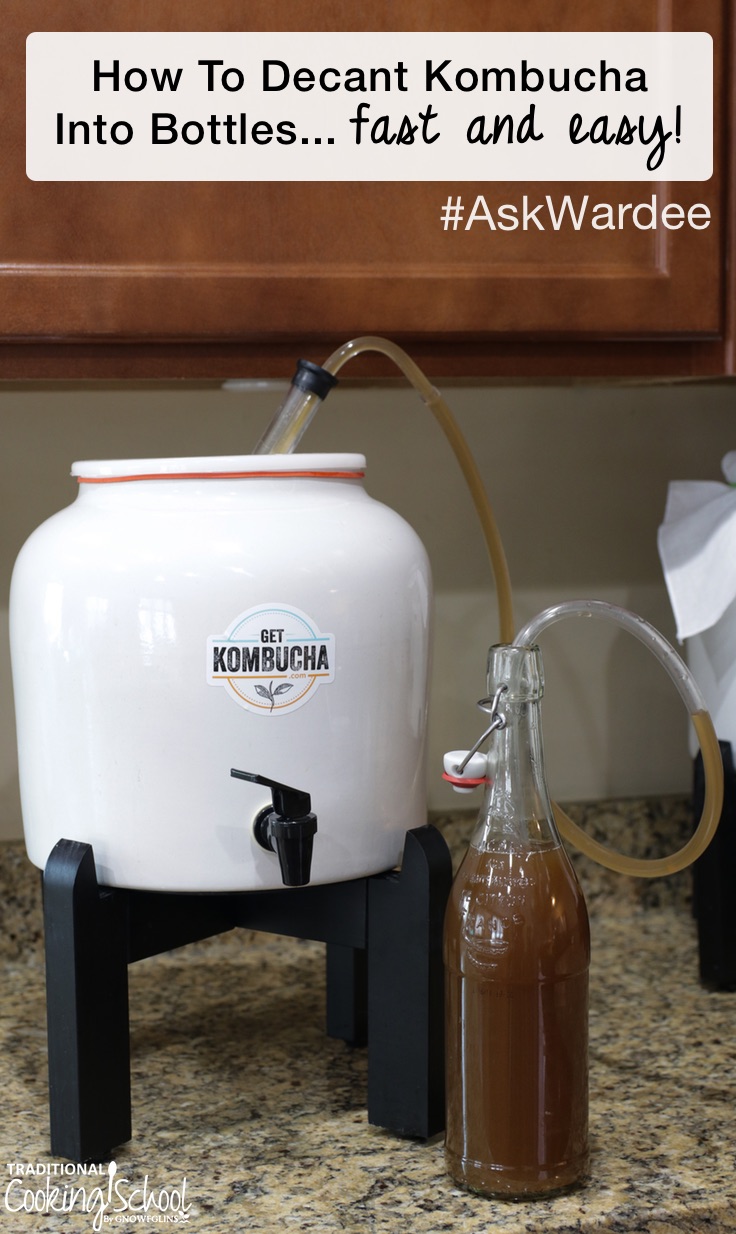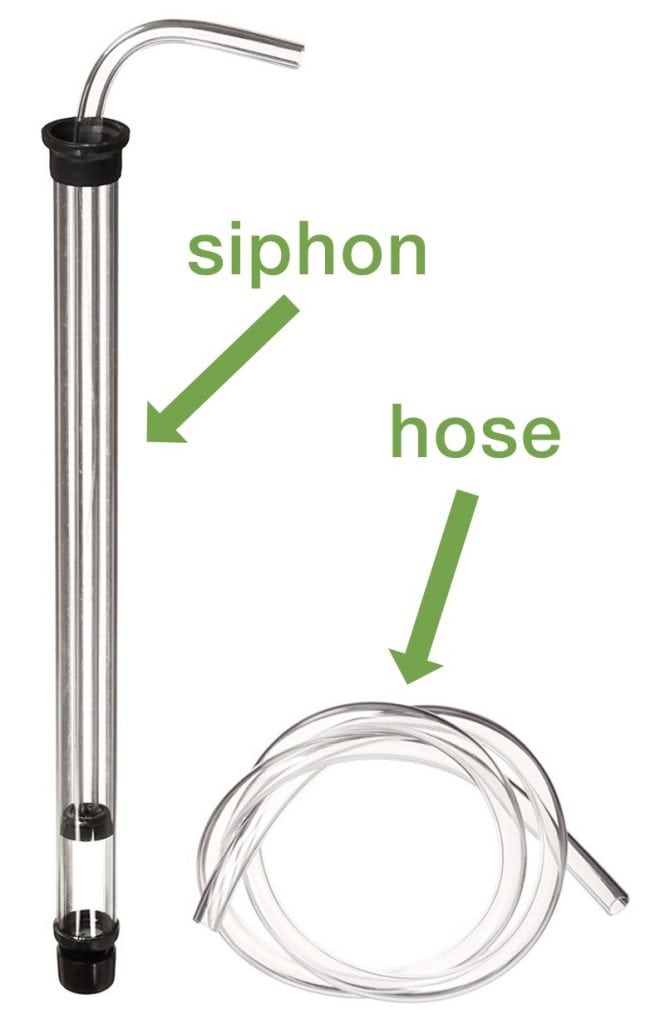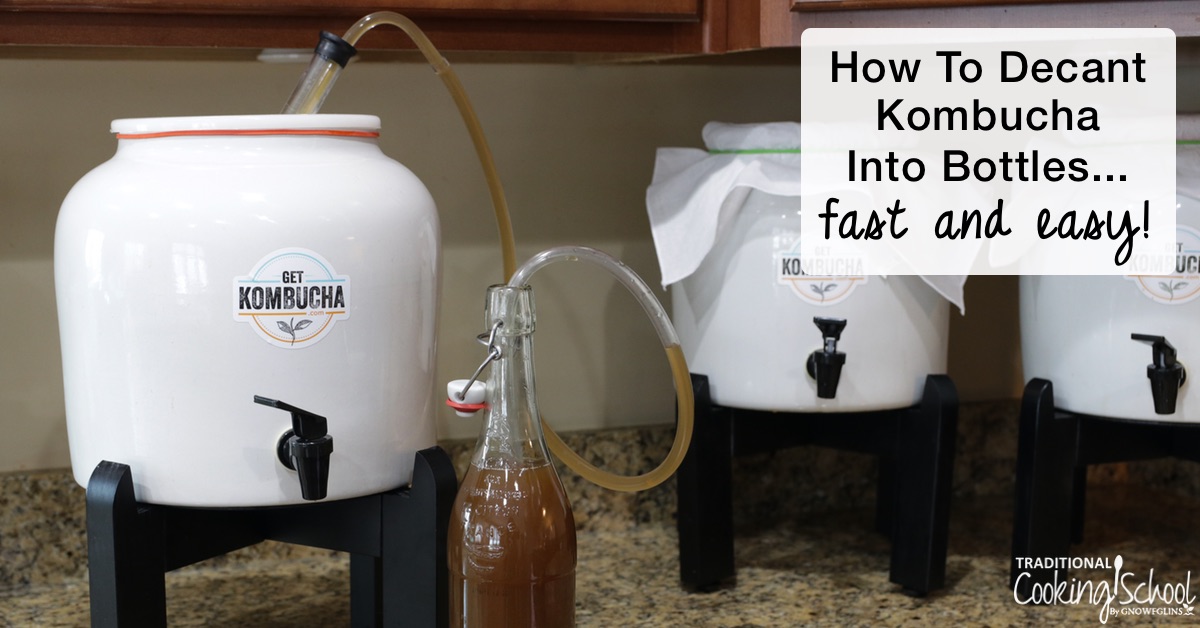
You’re decanting your homemade fermented, soda-like Kombucha into bottles…
…and sometimes the spigot gets clogged or just runs too slow (you could be doing other things!) or it’s messy or time-consuming…
…so you want a fast and easy way to transfer the Kombucha from the fermenting vessel into your bottles for the second ferment.
I hear you. We did, too. Or, I should say — my son did, too!
He’s been brewing our Kombucha for several years, and one day he asked for food grade tubing to decant it faster. He used that for awhile, and it was fine for just family.
However, he needed to put his mouth on it to get the Kombucha flowing through the tube and into the bottles (plus it’s tricky to control), so we thought it would be better to use something else so we could start serving his delicious, bottled Kombucha outside our family without any worries.
We found the perfect solution — the bottling auto siphon. It’s clean, fast, and easy! You’ll get your Kombucha decanted into bottles for their second ferment in no time!
I’m showing you how to use one on today’s #AskWardee. 🙂
By the way… click here for my Ultimate Guide To Kombucha {how to make it, store it, flavor it, SCOBY care, troubleshooting, and MORE!}.
Read, listen, or watch below!
Subscribe to #AskWardee on iTunes, Stitcher, YouTube, or the Podcasts app.
Q: How Do You Decant Kombucha Into Bottles?
Cherie P. asked:
Regarding the last kombucha episode, you mentioned your son uses a food grade hose to ‘siphon’ Kombucha out of the big jar to the storage jars.
Is there any chance that he would show us? I have tried and just can’t get that to work. I have tried the continuous brew spout, but it only seems to work for a couple days after a full cleaning before it clogs right back up with culture pieces again. Thanks so much!
Cherie, I’m happy to help! My son is ill right now, so I hope you’ll settle for me showing you. 🙂
How To Decant Kombucha Into Bottles… Fast & Easy!
By the way, need bottles for your Kombucha? Here’s what I recommend: these are dark and these are clear.
Depending on your fermenting vessel (for the first ferment), there are multiple ways to decant the Kombucha into the bottles. The first 2 are slow, and I only mention them to be thorough. We are going to focus on methods #3 and #4.
Method #1 — Decant From Pour Spout
If it’s a continuous brew system like this, you can decant right from the pour spout of the large vessel into the bottles.
Method #2 — Decant From Another Container
Pour the first fermented Kombucha into a glass measuring cup and pour it from there into the bottles.
Method #3 — Food Grade Tubing
Use food-grade tubing to transfer the first fermented Kombucha from the large fermenting vessels into the individual bottles. The downside to this is you have to “start the flow” by putting your mouth on the hose and sucking out the air, which creates a vacuum for the Kombucha to flow so it can fill your bottle.
To fill a bottle, put one end of the hose/tube inside the Kombucha fermenting vessel, then “start the flow” by sucking some air out of the other end of the tube (so it creates a vacuum for the Kombucha to start flowing) and put that end inside the bottle. Make sure the bottle and the tube inside it are below the end of the tubing that’s in the large container. To slow down or reverse the flow, raise it up. This is a fun method, but it can be messy or undesirable because 1) you have to put your mouth on the tube now and then, which isn’t ideal if you’re going to serve Kombucha to guests on a regular basis and 2) it’s easy to overflow bottles!
Method #4 — Bottling Auto Siphon
We love this method, and it’s now what my son uses exclusively! I just had to learn it myself last week when he was ill, so I thought I would show you all today in this episode.
You’ll use an (inexpensive!) auto bottling siphon like this (pictured above and right) to decant quickly and easily! Although it takes a bit to get the hang of it, it works a lot like #3 except you don’t have to put your mouth on any tubes. So, you can feel completely comfortable serving your Kombucha to family and friends. 🙂
The steps are:
- Attach the hose to the siphon, if it’s not already.
- Insert the siphon into the Kombucha fermenting vessel.
- Insert the hose into the empty bottle.
- Pump the siphon (see video) so the Kombucha will flow through the hose into the bottle.
- Keep pumping until the bottle is full or nearly full.
- Transfer the hose in the fermenting vessel, then get another bottle and repeat steps 3, 4, and 5 until all your bottles are full.
Please be careful! The Kombucha will continue to flow even if you need to stop mid-pump. If you need to stop the flow (to prevent your bottle overflowing) quickly lift the bottle up so it’s above the level of the siphon, then quickly transfer the hose into the fermenting vessel until your next bottle is ready.
Helpful Links
- How Far Apart To Space Your Ferments #AskWardee 089
- How To Bottle Kombucha… Aka Second Ferment It! #AskWardee 086
- Where To Buy Bottles
- Where To Buy A Live Kombucha Scoby
- My Kombucha Recipe
- FREE eBook: The Ultimate Guide To Kombucha {how to make it, store it, flavor it, SCOBY care, troubleshooting, and MORE!}
- Free Fermenting Formulas Cheat Sheet
What Is The #AskWardee Show?
The #AskWardee Show is the live weekly show devoted to answering your niggling questions about Traditional Cooking: whether it’s your sourdough starter, your sauerkraut, preserving foods, broth, superfoods or anything else to do with Traditional Cooking or your GNOWFGLINS lifestyle.
I share tips and resources, plus answer your questions about Traditional Cooking!
The Details
When: Wednesdays at 10am Pacific / 1pm Eastern
Where: Traditional Cooking School on Facebook Live
What If You Can’t Make It?
Don’t worry. You can catch the replays or listen to the podcast!
- Come back here to AskWardee.TV; all replays will be up within hours of airing live; the print notes are always posted at the same time I go live.
- Go to Traditional Cooking School on Facebook to view the Facebook Live replay.
- Subscribe to the #AskWardee podcast on iTunes, Stitcher, YouTube, or the Podcasts app. While you’re there, be sure to leave a rating and review!
Want To Get YOUR Question Answered?
Here’s how to submit your question. If we answer it on #AskWardee, you’ll get a gift!
Or, you can…
- Tweet your question to @TradCookSchool on Twitter; use hashtag #AskWardee
- Send an email to wardee at AskWardee dot tv — add #AskWardee to your email so I know it’s for the show
Please do NOT add future questions for #AskWardee to the comments of this post because they might get missed!
Do you use a siphon or similar system to decant your Kombucha into bottles? Please share your tips!
...without giving up the foods you love or spending all day in the kitchen!

2 free books:
Eat God's Way
Ditch the Standard American Diet, get healthier & happier, and save money on groceries...
We only recommend products and services we wholeheartedly endorse. This post may contain special links through which we earn a small commission if you make a purchase (though your price is the same).



I really like the container you’re using to brew your Kombucha, where can I get it? Also, I recently moved to a place where it is very cold, plus everything runs on electricity so my kitchen isn’t as warm as my previous home. I noticed my brew isn’t bubbling. How do I get the bubbles back? I read that you don’t need the bubbles to get a good brew but I want them. PLEASE HELP!
Hi Lenora,
The vessel is from Get Kombucha and is part of the continuous brew system Wardee uses. Here’s a link to learn more about it: https://traditionalcookingschool.com/videos/continuous-brew-kombucha-video/
We have an #AskWardee on helping with fizz. Here’s a link to that: https://traditionalcookingschool.com/q-a/askwardee/askwardee-024-help-kombucha-sweet-not-fizzy/
~Danielle, TCS Customer Success Team
Wardee, Merry Christmas and happy New Year! I love your episodes and while every one of them is not something that I would use, I do love your excitement and presentation. They’re fun to watch, so keep doing them!
One more piece that can be added to your auto-siphon is what’s called a bottling wand. It’s what we use (in the beer and wine brewing world) to stop the siphoning action that you indicated happens when the bottle is below the level of liquid in the fermenter. The tip of the bottling wand has essentially a spring or gravity assisted stopper. When you press it against the bottom of the bottle, that opens the wand and allows liquid to flow. When you pull up on the wand, the spring or gravity closes it and stops the flow. You can find them at any home brew supply shop (and I would recommend that over Amazon, support your small business whenever possible). My local homebrew store is Alternative Beverage (ebrew.com) and they have two versions of the 3/8″ wands (it appears that’s the size of hose you are using but you’ll want to verify based on the auto siphon you have)
http://ebrew.com/product722.html
http://ebrew.com/product719.html
One of the other benefits that you get with a bottling wand is the perfect headspace. In theory, you fill to the very top with the wand, and the volume of space that the wand takes (in the full bottle) is exactly the headspace needed to provide excellent carbonation and perfect presentation. Plus you know that every bottle is filled to the same exact level.
Of course, you can also find a homebrew store that’s closer to you. However I would recommend that if you look online, stay away from Northern Brewer and Midwest Supplies, they are AB-InBev owned so are even worse than Amazon regarding keep your dollars in the local community.
John
I have not gotten to the point where I need to decant my kombucha yet (I’m on my first brew) but I’ve read where some people have sediment/little wisps of the SCOBY that need to be drained off, and I’ve seen them use a screen with their funnel when they bottle. How would this system address the same issue?
Hi Amy,
You could use the screen and funnel. You would need to hold the tubing in place in over the screen while pumping.
~Danielle, TCS Customer Success Team